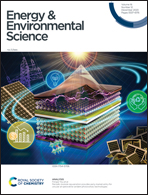Tuning the solution aggregation and molecular order for efficient and thermally stable polymer solar cells†
Abstract
The best-performing active layers for organic photovoltaics generally include semi-paracrystalline polymers. However, the solution aggregation and molecular order correlations of these photovoltaic blends and how they control the photovoltaic performance and operational stability remain elusive. Here, we show that the crystalline-amorphous interaction parameter plays a crucial role in determining the structure and performance of organic photovoltaic blends featuring semi-paracrystalline polymers. Solution small-angle neutron scattering and microstructure results reveal that the molecularly ordered 2D semi-paracrystalline polymer system P5TCN:Y6 achieves stronger aggregate rigidity in the blend solutions and inherits it in the films to form “locked” crystalline domains and intercrystalline links, which lead to the top-tier values and excellent thermal stability for polythiophene solar cells. By establishing correlations between various interaction parameters and solution structure parameters, we provide a comprehensive understanding of changes in aggregate rigidity of semi-paracrystalline polymers upon blending with nonfullerene acceptors and relationships between solution aggregation and performance of organic solar cells.

- This article is part of the themed collection: Energy & Environmental Science Recent HOT Articles


 Please wait while we load your content...
Please wait while we load your content...